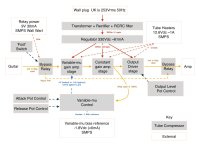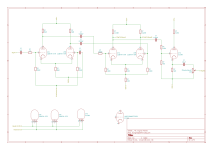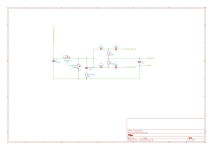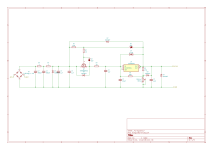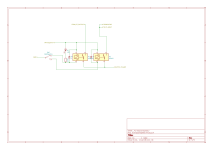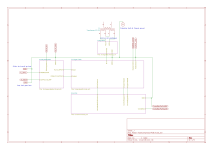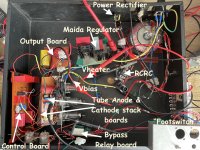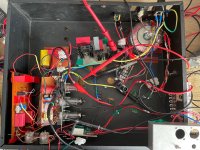3 videos uploading
* sine wave showing attenuation on scope
* guitar into scope showing attenuation
* guitar into amp where you can hear the difference vs hard hitting the front end of the JCM hight gain.
These are uploading and processing..
Signal generator+Scope
You can see the purple showing input, and the yellow output that's attenuated. Note that there's a little phase delay due to the decoupling caps between the stages like every tube amp has. I noted there's is a little cathode follower distortion, I can sort that out but not tonight, shown in the scope but if you listen there's a little coldness to the tone - that's the higher level harmonics off that distortion.
Next you can see better with the guitar signal, the attenuation.
Guitar+ scope
Then finally we have the guitar and amp..
Guitar + Amp
As I said the coldness is a little distortion - I'll have a look at that but for now that's good enough.
Next the schematic of the compressor itself:

Next up is the maida regulator, I made a number of changes to that and listed that in the post here: https://forum.pedalpcb.com/threads/high-voltage-hijinks.26775/post-345139 saves on repeating that.
What this regulator does is basically take the 1V ripple from the RCRC filter and reduces the ripple massively so that it doesn't cause a problem for the highly sensitive signal path. It's in the order of mV ripple on 350Vdc!
* sine wave showing attenuation on scope
* guitar into scope showing attenuation
* guitar into amp where you can hear the difference vs hard hitting the front end of the JCM hight gain.
These are uploading and processing..
Signal generator+Scope
You can see the purple showing input, and the yellow output that's attenuated. Note that there's a little phase delay due to the decoupling caps between the stages like every tube amp has. I noted there's is a little cathode follower distortion, I can sort that out but not tonight, shown in the scope but if you listen there's a little coldness to the tone - that's the higher level harmonics off that distortion.
Next you can see better with the guitar signal, the attenuation.
Guitar+ scope
Then finally we have the guitar and amp..
Guitar + Amp
As I said the coldness is a little distortion - I'll have a look at that but for now that's good enough.
Next the schematic of the compressor itself:
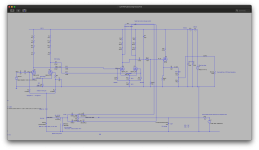
Next up is the maida regulator, I made a number of changes to that and listed that in the post here: https://forum.pedalpcb.com/threads/high-voltage-hijinks.26775/post-345139 saves on repeating that.
What this regulator does is basically take the 1V ripple from the RCRC filter and reduces the ripple massively so that it doesn't cause a problem for the highly sensitive signal path. It's in the order of mV ripple on 350Vdc!
Last edited:

